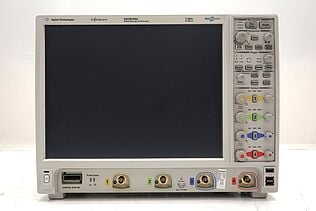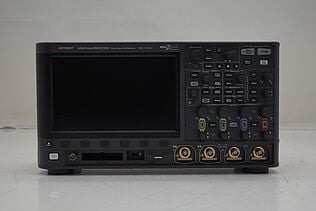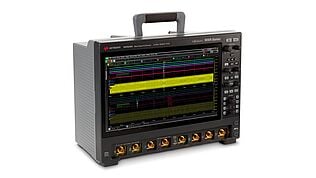- Introduction
- What Is an Oscilloscope?
- Benefits of Buying Used Oscilloscopes
- Choosing the Right Display Type
- Analog Oscilloscopes
- Digital Oscilloscopes
- Factors To Consider When Buying a Used Oscilloscope
- Bandwidth
- Sample Rate
- Memory Depth
- Connectivity
- Ease of Use
- How To Test Your Used Oscilloscope
- Common Mistakes People Make When Buying an Oscilloscope
- Final Tips on Buying Used Oscilloscopes
- Buy a Keysight Premium Refurbished Oscilloscope for a Fraction of the Price
- Did You Know?
- Closing Thoughts From Keysight
- Whenever You’re Ready, Here Are 4 Ways We Can Help You
Oscilloscopes are essential tools scientists and engineers use to study the periodic behavior of electrical signals on electronic equipment. Since oscilloscopes contain costly high-quality components they can be relatively expensive to buy. Buying a premium used oscilloscope is an excellent option if you want to pick up a quality oscilloscope at a fraction of the price.
When purchasing a used oscilloscope, ask yourself these questions to ensure you get the best scope for your needs.
- What type of oscilloscope do I need?
- What functions do I need the oscilloscope to have?
- Is the device in good working condition?
- Is it properly calibrated?
- What warranty is available?
Answering these questions will narrow down your search for the perfect used oscilloscope. With that in mind, let’s disccuss some important factors to consider when buying a used oscilloscope.
What Is an Oscilloscope?
The primary function of any oscilloscope is to measure voltage over time. It produces a graphical display of the waveform, which allows engineers and technicians to visualize the behavior of electrical signals.
Oscilloscopes are essential tools for debugging and designingelectronic circuits.They can measure frequency, time interval, amplitude, the rise time of signals, distortion, and how much of a signal is alternating current (AC) or direct current (DC). Oscilloscopes are available in various configurations, from handheld units to benchtop models with sophisticated features.
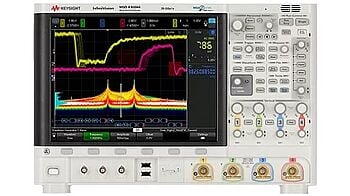
In its simplest form, an oscilloscope consists of a screen, a horizontal sweep unit, and a vertical input amplifier. The horizontal sweep unit produces a repeating electrical signal that travels left to right across the screen at regular intervals. The vertical input amplifier receives the measured signal and controls how high or low it appears on the screen.
When used together, these two units allow the oscilloscope to create a graphical representation displaying signal voltage as a function of time, which is used to analyze the behavior of the signal and to identify problems and develop solutions.
Benefits of Buying Used Oscilloscopes
When investing in an oscilloscope, you may automatically assume that you should purchase a brand-new model. However, this is not always the best option. Used oscilloscopes offer many advantages, especially if you are on a budget.
- Used models are often significantly cheaper than their brand-new counterparts. Some used oscilloscopes are up to 90% cheaper, a significant advantage for anyone working with limited funds.
- Used oscilloscopes often come with a warranty or return policy, so you can rest assured that you're making a safe purchase.
- Used oscilloscopes have been tested and proven to work, so you can be confident that you're getting a reliable device.
- Purchasing a used oscilloscope is an eco-friendly choice, as it helps to reduce electronic waste. With about 50 million tons of e-waste being produced each year globally, buying a used oscilloscope is a great way to do your part in reducing that number.
As you can see, many benefits come with buying a used oscilloscope. Whatever your budget, a used oscilloscope is a great option.

Choosing the Right Display Type
When deciding what oscilloscope to buy, one of the first things to consider is what type of display you want. When researching oscilloscope display types, you will likely find an overwhelming amount of information that is difficult to understand. So let's break down the oscilloscope types into two categories: analog display and digital display.
Analog Oscilloscopes
Analog oscilloscopes help engineers and technicians visualize an electrical signal's waveform. By graphing the signal amplitude over time, analog oscilloscopes provide a clear picture of the signal's characteristics.
Analog oscilloscopes use an electron beam to sweep across a phosphor-coated screen at a rate determined by the frequency of the input signal. When the electron beam hits the screen, it causes the phosphor to fluoresce, creating a bright spot on the display.
By sweeping the beam back and forth across the screen at a constant rate and varying the voltage applied to the input terminals, analog oscilloscopes can generate a visual representation of an electrical signal.
While analog scopes are no longer the state-of-the-art technology they once were, they remain popular due to their low cost and ease of use. Because of their intuitive nature and quick setup time, many seasoned engineers prefer analog oscilloscopes for specific applications.
| Analog Oscilloscope Pros | Analog Oscilloscope Cons |
|---|---|
| More rugged and durable than digital oscilloscopes. | Less accurate measurements than digital oscilloscopes. |
| Better signal-to-noise ratios, making them ideal for measuring weak signals. | Some models can be more expensive than digital oscilloscopes. |
| Low cost and simplicity. | More likely to give false readings, which can lead to incorrect conclusions about a circuit. |
| Easy to use and interpret. | Less portable than digital handheld oscilloscopes, making them less convenient for fieldwork. |
Digital Oscilloscopes
A digital storage oscilloscope (DSO) is a type of electronic test instrument that converts the waveform of the signal into a digital representation displayed on a screen. The basic principle behind a digital scope is quite simple: an electronic circuit produces a voltage that varies with time, which is fed into the oscilloscope's input.
It converts the input signal voltage into a digital format using an analog-to-digital converter (ADC). The ADC runs much faster than the input signal, typically several MHz. The scope triggers an event and then captures a certain number of samples before and after the trigger event. It displays the voltage vs. time waveform on the screen.
The oscilloscope then uses this voltage to produce a corresponding electric current passed through a resistor. This current is converted back into a voltage proportional to the original signal. The voltage is amplified and used to drive the display of the oscilloscope. By carefully controlling the amplification and other factors, the digital scope can accurately represent standard and complex waveforms.
The scope stores the waveform in memory so it can be recalled and analyzed later. In addition, the scope can perform mathematical operations on the waveform data, such as adding, subtracting, multiplying, and dividing, which allows the user to see the effects of these operations on the waveform.
| Digital Oscilloscopes Pros | Digital Oscilloscopes Cons |
|---|---|
| Increased accuracy and higher resolution. | May need specialized equipment or software to generate or view the waveforms, which can add to the cost of your overall setup. |
| Can store and recall waveforms, which is valuable for analyzing complex signals. | Can be more complex to use than analog scopes. |
| Can perform mathematical operations on waveforms and has a color display, which makes them easier to read than analog oscilloscopes. | More expensive than its analog counterpart. |
Overall, the advantages of a digital oscilloscope outweigh the disadvantages.
Factors To Consider When Buying a Used Oscilloscope
So far, we have looked at the benefits of buying a used oscilloscope , how to choose the right display type, and the pros and cons of digital vs. analog.
There are a few more factors to consider before you purchase a used oscilloscope.
- What is the scope's bandwidth?
- What is the sample rate?
- What is the scope's memory depth?
- What connectivity options does it have?
- Is the scope easy to use?
Considering these factors and researching ahead of time will help you find the perfect used oscilloscope for your needs. Let's look at each of the above points in more detail.
Bandwidth
Bandwidth is one of the most important factors when choosing a used oscilloscope. Bandwidth determines the frequency range that an oscilloscope can accurately reproduce. The higher the bandwidth, the higher the frequencies it can display. When buying a used oscilloscope, be sure to check what the specified bandwidth was at the time of manufacture.
It is important to consider the bandwidth requirements of your application. For example, working with high-speed digital signals, you will need an oscilloscope with high bandwidth to accurately capture all of the transient details.
A lower bandwidth may be sufficient if you use your oscilloscope for basic troubleshooting or time-domain analysis. Be sure to check the specs for both high and low-frequency performance before making your purchase.
Sample Rate
The sample rate of an oscilloscope is the number of samples taken per second. The higher the sample rate, the higher the signal resolution. Sample rate should be at least 2.5 more than the bandwidth. However, increasing the sample rate also increases the amount of data the oscilloscope has to process, slowing down its performance.
It is important to find a balance between resolution and speed when setting the sample rate. Some signal details can be captured accurately with a lower sample rate, while others may require a higher rate to be represented correctly. Ultimately, it is up to you to decide what trade-offs you are willing to make to get the desired picture detail.
For example, if you are testing a digital circuit with a fast edge rate, you will need to use a scope with a high sample rate to capture all of the details accurately. On the other hand, if you are looking at a slow-moving signal, you can get by with a lower sample rate.
There are two main types of sampling: real-time sampling and repetitive sampling.
- Real-time sampling. The oscilloscope samples the signal at regular intervals. The interval is set by the user and can be changed as needed. This type of sampling is best suited for signals that are not periodic or have a low frequency.
- Repetitive sampling. The oscilloscope samples the signal at a fixed interval. This type of sampling is best suited for signals that are periodic or that have a very high frequency.
Some oscilloscopes allow the user to set the sample rate manually, while others have an auto-sampling feature that automatically sets the sample rate based on the measured signal. Both methods have advantages and disadvantages, so be sure to choose an oscilloscope that offers the features you need.
Memory Depth
Memory depth is the amount of data an oscilloscope can store and display. The deeper the memory, the more information the scope will show you. This is important because it affects the resolution of the signal you’re viewing. The better the resolution, the more detail you will see in the signal.
A scope with shallow memory might only be able to store a few seconds’ worths of data, which might not be enough to really see what’s going on. But a scope with deep memory can keep hours’ or even days’ worth of data, letting you zoom in for a high-resolution view of whatever portion you’re interested in viewing.
Having a deeper memory can be helpful when you’re trying to track down an intermittent problem that only happens once in a while. Shallow memory might not capture the event at all, but deep memory will let you scroll back and look closely at what happened before and after the event.
A deep memory depth means that more of the waveform will be captured, while a shallow memory depth will only capture a small portion of the waveform. Deeper memory depths are useful for capturing complex waveforms, while shallower depths are sufficient for simple measurements.
Memory depth and sampling rate work hand in hand because the more samples you take per second, the more data you will have to store. As a result, scopes with higher sample rates will also have deeper memories.
Connectivity
Oscilloscope connectivity refers to how the oscilloscope can connect to the measured device. The most common type of connectivity is via probes, which are cables that attach to the oscilloscope's input. Some standard probes are alligator clips, BNC probes, SMA probes, and current probes.
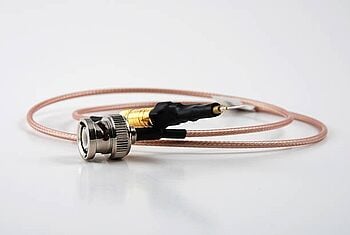
You will also need to connect the oscilloscope to a computer or other read-out device. It's important to remember that connectivity options may vary depending on the age and model of the used oscilloscope. Other types of oscilloscope connectivity include USB, RS-232, Ethernet, LAN, or WiFi.
- USB. The universal serial bus (USB) is a common oscilloscope connection. It’s a standard used on nearly all computers, making it easy to connect the oscilloscope to a PC. USB is also high-speed, so it can quickly transfer large amounts of data.
- RS-232. This serial connection is commonly used to connect the oscilloscope to a PC. The benefit of RS-232 is that it’s easy to use and widely available. It’s not as fast as USB, but it’s still fast enough for most purposes.
- Ethernet. This connection works using a standard ethernet cable, which is used to connect a computer to a router. For oscilloscopes, ethernet cables connect the scope to a network so it can be monitored and controlled remotely.
- LAN. Local area network (LAN) is similar to ethernet but offers a higher connection speed. It’s commonly used in industrial settings where large amounts of data are transferred from the oscilloscope to a computer.
- WiFi. This connection uses wireless signals to connect the oscilloscope to a network. It’s becoming increasingly common on newer oscilloscopes as it offers a convenient way to connect the scope without worrying about cables. Older models might not have WiFi connectivity, so keep that in mind when deciding which model to buy.
Ease of Use
Ease of use is important when purchasing an oscilloscope for several reasons.
- If you have difficulty understanding how to operate the oscilloscope, it will limit its usefulness.
- If you cannot quickly and easily navigate the oscilloscope’s menus and settings, you are likely to make errors that could lead to inaccurate measurements.
- An oscilloscope that is difficult to use is likely to be frustrating to work with, leading to operator error and decreased productivity. By contrast, an oscilloscope that is easy to use will produce more accurate results and be more enjoyable to work with.
- Older models may not be able to use current, up-to-date software, making them challenging to use. They may not be able to stay up-to-date with current software, which could affect their accuracy.
When considering ease of use, remember that a well-designed oscilloscope should be intuitive and straightforward.
How To Test Your Used Oscilloscope
Once you have bought a used oscilloscope, you will want to test its operations to ensure it works as expected. Let's look at how you would set up and test your oscilloscope.
- Gather the equipment. You will need an oscilloscope, probe, BNC cable, ground lead, and power cord.
- Ensure that the power to the oscilloscope is off and disconnect all cables from the scope input channels.
- Connect the ground lead to the ground terminal.
- Connect the probe to channel 1 of the oscilloscope by matching the probe wire and scope channel colors.
- Screw down firmly on the probe so it makes a good connection with Channel 1.
- Take your BNC cable and connect one end to the trigger out port on your scope.
- Connect one end of your second BNC cable to channel 2 of your scope (making sure to match colors).
- Connect both BNC cables into their respective places on your splitter box or Y-cable connector.
- Turn on your DUT (Device Under Test).
- Turn on the power for your oscilloscope using the switch located on the back panel.
And that’s it! You have now successfully set up your oscilloscope. But how do you test it for accuracy and functionality?
- Check that all input and output connections are secure and in good working condition.
- Power on the oscilloscope and observe the startup screen to ensure all the information is legible.
- Use a known signal source to generate a test waveform.
- Observe the waveform on the oscilloscope screen and note any distortion or abnormalities, such as missing parts of the waveform or incorrect scaling.
- Compare your observations to the oscilloscope specifications to ensure it is performing within acceptable tolerances.
By following these steps, you can be confident that your used oscilloscope is in good working condition.
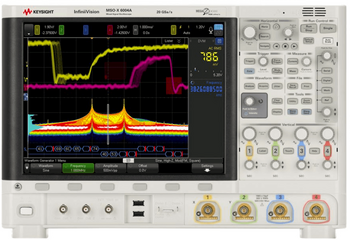
Common Mistakes People Make When Buying an Oscilloscope
- Not choosing the scope with the right specs for the job. Oscilloscopes come in a wide range of shapes, sizes, and specifications. It's essential that you select the scope with the proper specifications for your needs. For example, do you need a mixed signal oscilloscope? Do you need a portable scope to use in the field? Answering these questions before purchasing can save you many headaches in the future.
- Using wrong probes. Oscilloscope probes come in various types, each designed for specific applications. It's crucial to ensure you're using the proper probe for your needs. For example, passive probes are not recommended for high-speed digital applications.
- Not testing the device. As discussed above, testing your used oscilloscope is essential as soon as you buy it and before using it on critical applications. Not doing so could result in inaccurate measurements and data.
By avoiding these mistakes, you can be confident that you're getting a used oscilloscope that meets your needs and is in good working order.
Final Tips on Buying Used Oscilloscopes
Buying a good-quality used oscilloscope doesn't have to be complicated or stressful. By following the tips mentioned in this article, you can be confident that you're getting a scope that meets your needs and is in good working condition.
Some final tips to keep in mind:
- Consider the life expectancy of an oscilloscope. Since you are buying a used device, make sure to find out how old the scope is.
- If you plan on using your scope with modern software, ensure it is compatible with the new software.
- When buying online, always check the seller's reviews to ensure they are reputable.
- Ensure the seller has a good return policy in case the scope is not as described.
- Don’t expect spare parts to be readily available. Depending on the model's age, it may be challenging to find replacement parts.
- To be sure you're getting a quality scope, only buy from trusted manufacturers such as Keysight.
Buy a Keysight Premium Refurbished Oscilloscope for a Fraction of the Price
Buying a used oscilloscope can be a great way to save money. However, ensuring you're getting a quality scope that meets your needs is important. By keeping in mind the tips mentioned in this article, you can be confident you're getting an oscilloscope that will serve you well for years to come.
Keysight offers a wide range of high-quality, premium refurbished oscilloscopes backed by a 1-year warranty. You can rest easy knowing you're getting a quality product backed by a trusted manufacturer.
So don't wait; see our premium used equipment page and pick up a premium refurbished oscilloscope with some of the highest standards and specifications in the industry.
Did You Know?
Keysight is the only company that can provide calibration. When you buy from our Used Equipment page, you can rest easy knowing that your oscilloscope has been thoroughly tested and calibrated. You can get straight to work using a reliable and accurate piece of equipment of the highest standard. No other reseller can provide that guarantee. That’s why choosing Keysight for refurbished products is always the smartest choice.
While other resellers' shipping times vary from 8-21 weeks, we ensure that our oscilloscope will reach your door within two weeks*. That’s the Keysight difference! Request a quote today by browsing models below!

Closing Thoughts From Keysight
As we have looked at in this article, there are many benefits to buying a used oscilloscope. Purchasing a used oscilloscope is a great way to save money but not forgo quality.
When you purchase premium refurbished equipment from Keysight, you can have confidence knowing you are buying a brand you can trust. They come with a reliable warranty and are thoroughly tested, calibrated, and proven to work.
Keysight is a leading manufacturer of quality oscilloscopes, offering a wide range of models to meet your specific needs. We also have a large variety of premium used oscilloscopes at a fraction of the cost.
With a fast two-week delivery time* within the US and upgradable warranty, buying used is a wise investment if you're looking for quality and affordability. See Keysights Used Equipment for the widest selection of discounted, high-quality oscilloscopes.
Whenever You’re Ready, Here Are 4 Ways We Can Help You
- Browse our premium used oscilloscopes offers
- Call tech support US: 1 800 829-4444
Press #, then 2. Hours: 7am – 5pm MT, Mon– Fri - Talk to our sales support team by clicking the icon (bottom right corner) on every offer page
- Talk to your account manager for custom deals

Subscribe to Get Our Latest News, Updates, and Articles.
* Two weeks shipping time offer available for US customers only. Dependent on item availability and location




